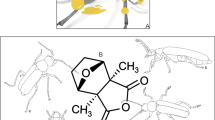Abstract
Cantharidin, a potent vesicant and antifeedant, is identified for the first time in two oedemerid beetles from the western hemisphere. Amounts of the substance per beetle were found to range from 2 to 7 μg inHeliocis repanda and from 15 to 35 μg inOxycopis thoracica. Females had two to three times more cantharidin than males of the same species. Cantharidin loads of these beetles are sufficient to irritate human skin.
Similar content being viewed by others
References
Arnett, R.H., Jr. 1984. The false blister beetles of Florida (Coleoptera: Oedemeridae). Entomology Circular No. 259, Florida Department of Agriculture and Consumer Services, Gainesville, Florida.
Carrel, J.E. 1971. Chemical defenses with immediate and delayed effects. PhD thesis. Cornell University, Ithaca, New York.
Carrel, J.E., andEisner, T. 1974. Cantharidin: Potent feeding deterrent to insects.Science 183:755–757.
Carrel, J.E., Doom, J.P., andMcCormick, J.P. 1985. Quantitative determination of cantharidin in biological materials using capillary gas chromatography with flame ionization detection.J. Chromatogr. Biomed. Appl. 342:411–415.
Dixon, A.P.G., Martin-Smith, M., andSmith, S.J. 1963. Isolation of cantharidin fromMeloe proscarabeus.Can. Pharm. J. 96:501–503.
Fleisher, T.L., andFox, I. 1970. Oedemerid beetle dermatitis.Arch. Dermatol. 101:601–605.
Herms, W.B. 1925. Entomological observations on Fanning and Washington Islands, together with general biological notes.Pan-Pac. Entomol. 2:54.
Kurosa, K. 1958. On the bionomics and pathogenicity of Oedemerid beetles (studies on poisonous beetle, I).Jpn. J. Sanit. Zool. 9:130–148.
Kurosa, K. 1977. Poisonous beetles (Oedemeridae), pp. 126–131,in M. Sasa, H. Takahasi, R. Kano, and H. Tanaka (eds.). Animals of Medical Importance in the Nansei Islands in Japan. Shinjuku Shodo, Tokyo.
Kurosa, K., andWatanabe, H. 1958. On the toxic substance ofXanthochroa waterhousei (Coleoptera: Oedemeridae).Jpn. J. Sanit. Zool. 9:200–201.
Sierra, J.R., Woogon, W.-D., andSchmid, H. 1976. Transfer of cantharidin during copulation from the adult male to the femaleLytta vesicatoria (“Spanish flies”).Experientia 32:142–144.
Sollman, T. 1948. A Manual of Pharmacology, 7th ed. Saunders, Philadelphia.
Vaurie, P. 1951. Blistering caused by oedemerid beetles.Coleopt. Bull. 5:78–79.
Walter, W.G., andCole, J.F. 1967. Isolation of cantharidin fromEpicauta pestifera.J. Pharm. Sci. 56:174–176.
Author information
Authors and Affiliations
Rights and permissions
About this article
Cite this article
Carrel, J.E., Doom, J.P. & McCormick, J.P. Identification of cantharidin in false blister beetles (Coleoptera, Oedemeridae) from florida. J Chem Ecol 12, 741–747 (1986). https://doi.org/10.1007/BF01012106
Received:
Accepted:
Issue Date:
DOI: https://doi.org/10.1007/BF01012106




